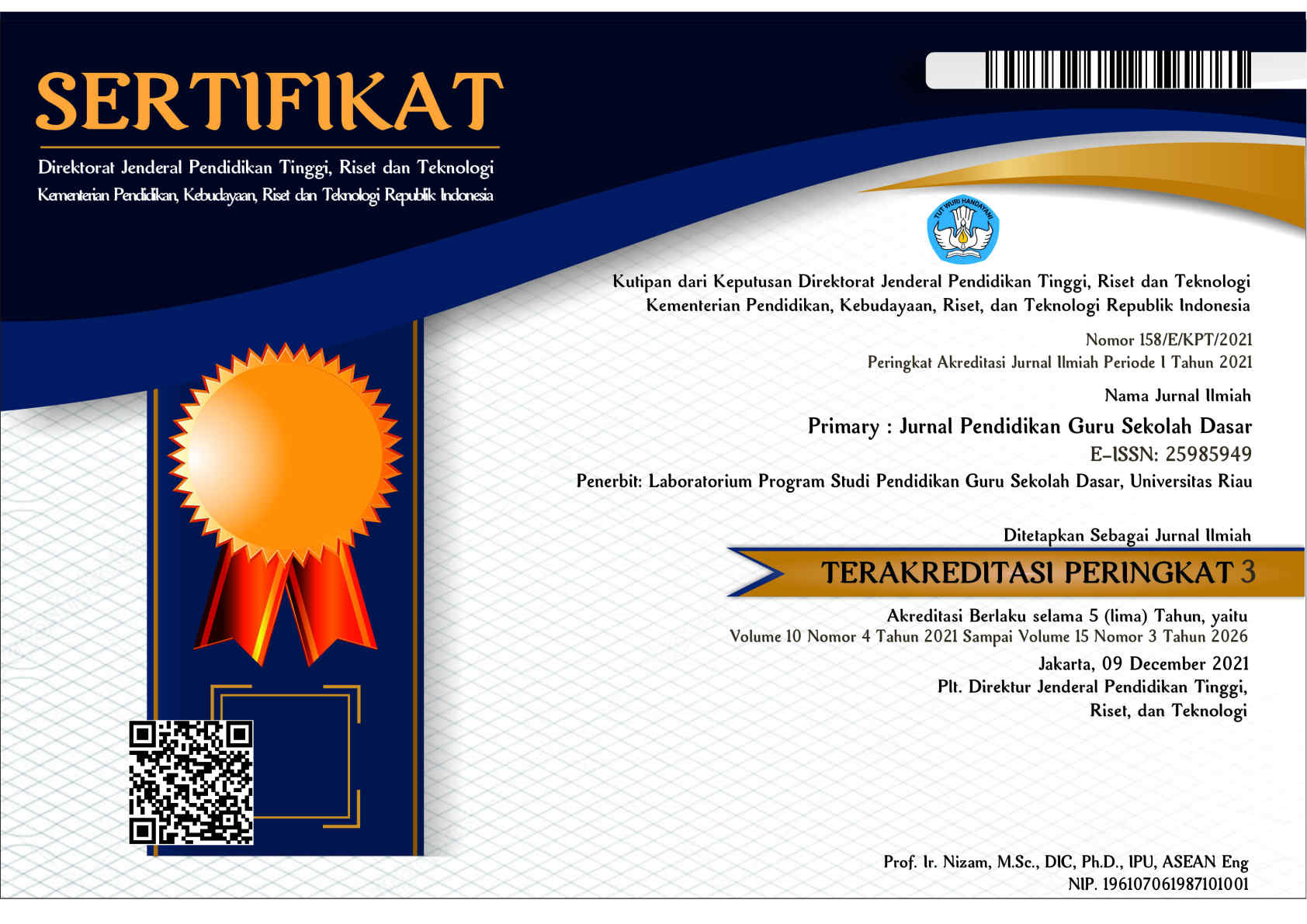PENERAPAN MODEL PEMBELAJARAN VISUALIZATION, AUDITORY, KINESTETIC (VAK) TERHADAP KEMAMPUAN BERPIKIR KREATIF SISWA PADA MATA PELAJARAN IPA
Abstract
This research was a quantitative study with a quasi-experimental research type. The purpose of this study was to determine the differences in creative thinking skills between students taught by visualization, auditory, kinesthetic (VAK) model and students taught by direct learning model. This research was conducted at grade IV SDN 2 Pagelaran. The data collection technique was done by testing. The main instrument in this research was a test of students' creative thinking skills. Then, data were analyzed through descriptive statistic data and inferential statistical data. The posttest results revealed that the average score of students' creative thinking skills in the experimental class was 68.8, while the average score in the control class was 58.6. It was seen from the average difference test that the comparison of the testing criteria was tcount ≥ ttable or 4.41 ≥ 2.019. From the results, it was stated that there was a difference in students' creative thinking abilities between the control class and the experimental class. After that, it was also tested with the right side test in which tcount ≥ ttable or 4.09 ≥ 1.671, with a significant level of 0.05. Based on the results, it was concluded that the students had better creative thinking abilities after being taught by visualization, auditory, kinesthetic (VAK) model than students taught by direct learning model.
Keywords
Full Text:
PDF (Bahasa Indonesia)References
Arifin. (2010). Penelitian Pendidikan. Bandung: PT Remaja Rosdakarya.
Arikunto, S. (2013). Prosedur Penelitian Suatu Pendekatan Praktik. Jakarta: PT Rineka Cipta.
Huda, M. (2013). Model-model Pengajaran dan Pembelajaran. Malang: Pustaka Belajar.
Indrawati. (2011). Modul Model-Model Pembelajaran. Jember: FKIP Universitas Jember.
Iskandar. (2001). Pendidikan IPA II. Depdikbud Drijen Dikti.
Joyce, B. & Weil, M. (1996). Models of Teaching. USA: Allyn and Bacon.
Munandar, S, C. (2012). Pengembangan Kreativitas Anak Berbakat. Jakarta: Rineka Cipta.
Purwanto. (2009). Evaluasi Hasil Belajar. Surakarta: Pustaka Belajar.
Riduwan. (2010). Skala Pengukuran Variabel-variabel Penelitian. Bandung: Alfabeta.
Samatowa, U. (2011). Pembelajaran IPA di Sekolah Dasar. Jakarta: PT Indeks.
Satria, E., & Widodo, A. (2020). View of teachers and students understanding’of the nature of science at elementary schools in Padang city Indonesia. In Journal of Physics: Conference Series (Vol. 1567, No. 3, p. 032066). IOP Publishing.
Satria, E. (2015). Improving Students Activities And Learning Outcomes In Natural Science In Class V By Using Somatic Auditory Visual Intellectual (SAVI) with Science KIT Seqip In SD Negeri 25 Seroja Lintau. In The International Conference on Mathematics, Science, Education and Technology (ICOMSET 2015).
Shoimin, A. (2014). Model Pembelajaran Inovatif dalam Kurikulum 2013. Yogyakarta: Ar-Ruzz Media.
Sugiyono. (2011). Metode Penelitian Pendidikan Pendekatan Kuantitatif, Kualitatif, dan R&D. Bandung: Alfabeta.
Suryanto. (2010). Sejarah Pendidikan Matematika Realistik Indonesia (PMRI). Yogyakarta: FMIPA.
Suryadi, D, & Herman, T. (2008). Pembelajaran Pemecahan Masalah. Jakarta: Karya Duta Wahana.
Susanto, A. (2013). Teori Belajar dan Pembelajaran di Sekolah Dasar. Jakarta: Kencana Prenada Media Grup.
DOI: http://dx.doi.org/10.33578/jpfkip.v10i2.8089
Refbacks
- There are currently no refbacks.
Copyright (c) 2021 Ayu Fiyanti Rahmadani, Nana Hendracipta, Encep Andriana

This work is licensed under a Creative Commons Attribution-NonCommercial-ShareAlike 4.0 International License.
____________________________________________________________
Primary: Jurnal Pendidikan Guru Sekolah Dasar
Secretariat
Program Studi Pendidikan Guru Sekolah Dasar
Gedung B1, FKIP Universitas Riau
Kampus Bina Widya Km. 12,5 Simpang Baru Panam
Pekanbaru Riau Indonesia 28293
e-mail : primary@ejournal.unri.ac.id



